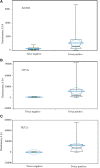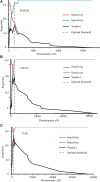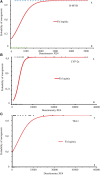Over Expressed TKTL1, CIP-2A, and B-MYB Proteins in Uterine Cervix Epithelium Scrapings as Potential Risk Predictive Biomarkers in HR-HPV-Infected LSIL/ASCUS Patients
- PMID: 31001477
- PMCID: PMC6456695
- DOI: 10.3389/fonc.2019.00213
Over Expressed TKTL1, CIP-2A, and B-MYB Proteins in Uterine Cervix Epithelium Scrapings as Potential Risk Predictive Biomarkers in HR-HPV-Infected LSIL/ASCUS Patients
Abstract
High oncogenic risk human papillomaviruses (HR-HPVs) promote cervical carcinoma development, the fourth most common feminine cancer. A slow oncodevelopmental phase-defined histopathologically as Cervical Intraepithelial Neoplasia (CIN) grades 1-3, or cytologically as Low- or High-grade Squamous Intraepithelial Lesions (LSIL or HSIL)-precedes the malignancy. Cervical carcinoma screenings through HR-HPV genotyping and Pap smears are regularly performed in Western countries. Faulty cytology screening or genotyping or patients' non-compliance with follow-ups can let slip an oncoprogression diagnosis. Novel biomarker tests flanking HR-HPV genotyping and cytology could objectively predict the risk of disease progression thus helping triage LSIL/ASCUS patients. Here, anonymized leftovers of fresh cervical epithelium scrapings from twice (LSIL/ASCUS and HR-HPV DNA)-positive and twice (Pap smear- and HR-HPV DNA)-negative (control) patients in a proteome-preserving solution served to assess the biomarker worth of three cervical carcinoma-related proteins, i.e., B-MYB (or MYBL2), Cancerous Inhibitor of PP2A (CIP-2a), and transketolase-like1 (TKTL1). Leftovers anonymity was strictly kept and storage at -80°C, protein extraction, immunoblotting, and band densitometry were blindly performed. Only after tests completion, the anonymous yet code-corresponding HR-HPV-genotyping and cytology data allowed to assign each sample to the twice-positive or twice-negative group. Descriptive statistics showed that the three proteins levels significantly increased in the twice-positive vs. twice-negative scrapings. Diagnostic ROC curve analysis identified each protein's Optimal Decision Threshold (OTD) showing that TKTL1 and CIP-2a are stronger risk predictive biomarkers (Sensitivity, 0.91-0.93; Specificity, 0.77-0.83) than B-MYB. Logistic Regression coupled with Likelihood-Ratio Tests confirmed that a highly significant relation links increasing TKTL1/CIP-2a/B-MYB protein levels in twice-positive cervical scrapings to the risk of HR-HPV-driven oncoprogression. Finally, a 3 year clinical follow-up showed that 13 patients (50% of total) of the twice-positive group with biomarker values over OTDs compliantly underwent scheduled colposcopy and biopsy. Of these, 11 (i.e., 84.7%) received a positive histological diagnosis, i.e., CIN1 (n = 5; 38.5%) or CIN2/CIN2+ (n = 6; 46,2%). Therefore, TKTL1/CIP-2a/B-MYB protein levels could objectively predict oncoprogression risk in twice (HR-HPV- and Pap smear)-positive women. Further studies will assess the translatability of these findings into clinical settings.
Keywords: ASCUS; B-MYB; CIP-2a; LSIL; TKTL1; human cervical carcinoma; oncogenic papillomaviruses; predictive biomarker.
Figures





References
-
- International Agency for Research on Cancer IARC; Monographs on the Evaluation of Carcinogenic Risks to Humans. IARC Monographs Volume 100 (B). Lyon: IARC; (2012). Available online at: https://monographs.iarc.fr/wp-content/uploads/2018/06/mono100B-11.pdf
LinkOut - more resources
Full Text Sources
Research Materials

